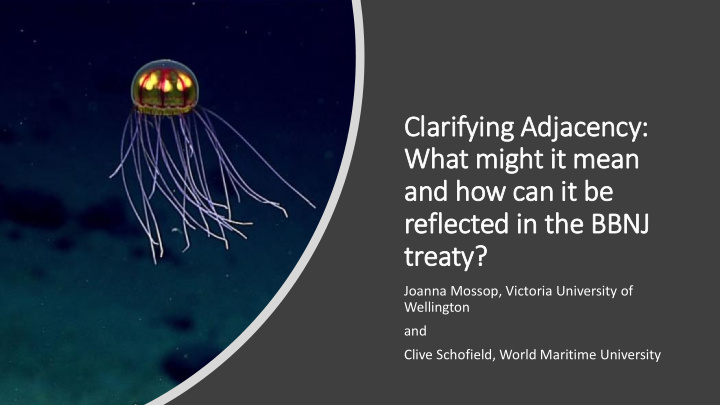



Cla larify fying Adja jacency: What mig ight it it mean and how can it it be reflected in in the BBNJ treaty? Joanna Mossop, Victoria University of Wellington and Clive Schofield, World Maritime University
Horizontal connectivity Vertical connectivity Areas beyond national jurisdiction (ABNJ)
Horizontal connectivity Popova et al, Marine Policy, 2019
Woods Hole Oceanographic Institution Vertical Connectivity
“… [S]o long as adjacent States can prove that their management measures conserve marine biodiversity within or beyond their national jurisdiction, the over-arching conservation mandate of UNCLOS would support granting to those States greater influence over management of those ABNJ resources to which they lie adjacent. Under this approach, those qualified adjacent States would be allocated the primary responsibility to coordinate with existing sectoral and regional organizations to become the leading architects of new regional conservation agreements.”
Towards a functional approach to adjacency Coastal states Other states a) their existing rights are protected; a) coastal states do not impact high seas biodiversity unduly negatively, b) that activities that could impact on activities and the marine environment and within national jurisdiction only proceed b) that high seas freedoms are not after consultation with potentially affected states; undermined. c) that coastal states have access to mechanisms that allow them to propose measures to protect biodiversity that has an ecological and cultural connection for their people; and d) that the instrument provides a pragmatic and workable process that provides legal certainty and will not be bogged down in debates over interpretation.
What is an ‘adjacent state’? • Could be defined: • Geographically proximate and/or • Potentially affected state and/or • ‘Range’ state through which migratory species travel (see CMS Convention) • Use specific language in the appropriate context • E.g. consultation with “potentially affected states” may be best for EIAs • For ABMT, may want to refer to adjacent states to indicate geographical proximity to EEZ and/or above continental shelf
Relationship between adjacency and due regard • ‘Due regard’ for the interests of coastal states provides procedural rights. E.g. • The impacts of activities or other measures on the high seas on areas under national jurisdiction should be part of the decision making process. Notification and consultation are important. • Process allowing coastal states to raise concerns about impacts of activities in ABNJ. • Limited substantive rights, but arguably ‘due regard’ for the interests of coastal states would imply giving consideration to not undermining the coastal state measures for the conservation and sustainable use of marine biodiversity in areas within national jurisdiction. No veto.
The special case of the continental shelf • On the extended CS, coastal states have sovereign rights to some parts of benthic ecosystems i.e. sedentary species. Therefore, have a legitimate interest in the conservation and sustainable use of the entire ecosystem. • What would ‘due regard’ involve in this context? • Special role in the proposal and establishment of ABMTs to protect the benthic environment • Obligation to, at least , notify the coastal state if collecting samples of benthic marine species on an ECS. Possibility that the coastal state could impose conditions including sharing data, having observers, etc. If directly sampling sedentary species, must get coastal state consent.
• Adjacency as conceptualised by Dunn et al unlikely to be accepted • BBNJ treaty does need framework for managing the interface between areas within and beyond national jurisdiction. States can choose to give content to adjacency. • Adjacency could: • respect the existing balance of rights Conclusions • involve states having due regard for the rights and interests of other states, both within and beyond national jurisdiction • encourage a regional approach to oceans management, either under the COP or in existing bodies • require specific provision for issues arising from the intersection between areas within and beyond national jurisdiction. E.g. the extended continental shelf and overlapping claims, MGRs
Questions? Joanna Mossop Joanna.mossop@vuw.ac.nz
Recommend
More recommend